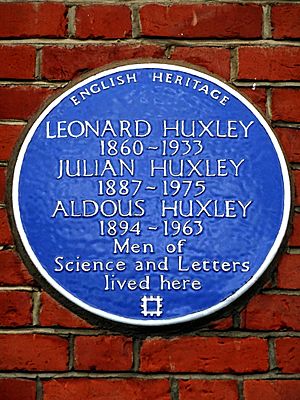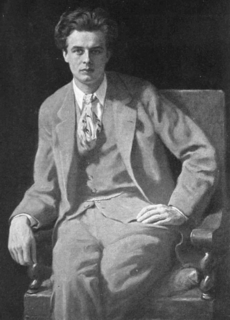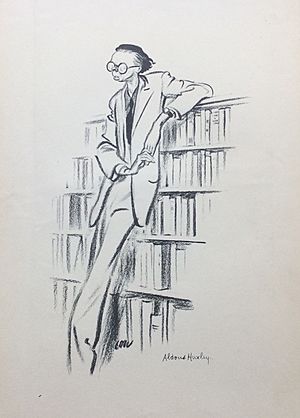Aldous Huxley facts for kids
Quick facts for kids
Aldous Huxley
|
|
|---|---|

Huxley in 1954
|
|
| Born |
Aldous Leonard Huxley
26 July 1894 Godalming, Surrey, England
|
| Died | 22 November 1963 (aged 69) |
| Education | Eton College |
| Alma mater | Balliol College, Oxford |
|
Notable work
|
|
| Spouse(s) |
|
| Era | 20th-century philosophy |
| Region | Western philosophy |
| School | Perennialism |
|
Main interests
|
|
|
Influences
|
|
| Signature | |
Aldous Leonard Huxley (/ˈɔːldəs/ awl-dəs; 26 July 1894 – 22 November 1963) was a famous English writer and thinker. He wrote nearly 50 books, including novels, non-fiction, essays, and poems.
Born into the well-known Huxley family, he studied English literature at Balliol College, Oxford. Early in his career, he wrote short stories and poetry. He also worked as an editor for the Oxford Poetry magazine. Later, he wrote travel stories, funny satires, and movie scripts.
Huxley spent the last part of his life in the United States, living in Los Angeles from 1937 until he passed away. By the end of his life, he was seen as one of the smartest people of his time. He was nominated for the Nobel Prize in Literature nine times. In 1962, he became a Companion of Literature by the Royal Society of Literature.
Huxley believed in peace and was against war. He became interested in mysticism, which is about spiritual experiences, and universalism, the idea that all people can be saved. He wrote about these ideas in his books. His most famous novel, Brave New World, describes a future society that is not ideal (a dystopia). His last novel, Island, describes a perfect society (a utopia).
Contents
Aldous Huxley's Early Life

Aldous Huxley was born in Godalming, England, in 1894. He was the third son of Leonard Huxley, a writer and schoolmaster. His mother, Julia Arnold, started Prior's Field School. Julia was also the niece of the famous poet Matthew Arnold.
Aldous was the grandson of Thomas Henry Huxley, a well-known zoologist and supporter of Charles Darwin. His brother Julian Huxley and half-brother Andrew Huxley also became important biologists. As a child, Aldous was nicknamed "Ogie." His brother Julian said he often thought about "the strangeness of things."
Education and Eye Problems
Huxley first learned in his father's science lab. Then he went to Hillside School, where his mother taught him for several years. After that, he attended Eton College. His mother died in 1908 when he was 14.
In 1911, when he was 16, Huxley got an eye disease called Keratitis punctata. This made him "practically blind for two to three years." Because of this, he could not become a doctor, which was his dream. His eyesight later got a bit better.
In October 1913, Huxley went to Balliol College, Oxford, to study English literature. In 1916, he tried to join the British Army for World War I. However, he was rejected because he was half-blind in one eye. He graduated from Oxford with top honors in June 1916.
After college, Huxley needed a job. He taught French for a year at Eton College. One of his students was Eric Blair, who later became the famous writer George Orwell. Huxley was not very good at keeping order in class. But his students, including Orwell, said he was excellent at language.
In the 1920s, Huxley also worked at a chemical plant called Brunner and Mond. This experience helped him write his science fiction novel Brave New World. He saw how an "ordered universe" worked in a world that often felt chaotic.
Aldous Huxley's Career

Painting of Huxley (at age 32) by John Collier (1927)
|
Huxley wrote his first novel when he was 17, but it was not published. He started writing seriously in his early twenties and became a successful writer. His first published novels were social satires, making fun of society. These included Crome Yellow (1921), Antic Hay (1923), Those Barren Leaves (1925), and Point Counter Point (1928).
Brave New World (1932) was his fifth novel. It was his first book about a dystopia, a future society where things have gone wrong. In the 1920s, he also wrote for magazines like Vanity Fair and British Vogue.
Meeting the Bloomsbury Group

During World War I, Huxley spent time at Garsington Manor. This was the home of Lady Ottoline Morrell. He worked there as a farm laborer. At the Manor, he met members of the Bloomsbury Group, a famous group of writers and artists. These included Bertrand Russell and Clive Bell. Huxley later made fun of the Garsington lifestyle in his novel Crome Yellow.
In 1919, Huxley got a job at the Athenaeum magazine. He quickly married Maria Nys (1899–1955), a Belgian refugee he met at Garsington. They lived in Italy for part of the 1920s and visited his friend D.H. Lawrence. After Lawrence died in 1930, Huxley edited his letters. In 1929, Huxley met Gerald Heard, a writer and philosopher.
Huxley's books from this time explored how scientific progress could make people less human. This was a main theme in his masterpiece, Brave New World. This novel is set in a future London. It shows a society based on mass production and conditioning people's behavior. Huxley was also influenced by F. Matthias Alexander, whom he based a character on in Eyeless in Gaza.
During this period, Huxley also wrote non-fiction books about peace. These included Ends and Means (1937) and An Encyclopedia of Pacifism. He was an active member of the Peace Pledge Union, an organization that promotes peace.
Life in the United States
In 1937, Huxley moved to Hollywood with his wife Maria, son Matthew Huxley, and friend Gerald Heard. He lived in the U.S., mostly in southern California, until he died. For a time, he lived in Taos, New Mexico, where he wrote Ends and Means. This book discussed topics like war, religion, and ethics.
Gerald Heard introduced Huxley to Vedanta, a type of Hindu philosophy. He also learned about meditation and vegetarianism through the idea of ahimsa (non-violence). In 1938, Huxley became friends with Jiddu Krishnamurti, a spiritual teacher. Huxley greatly admired Krishnamurti's ideas.
Huxley became a follower of Hindu Swami Prabhavananda. He wrote his book The Perennial Philosophy about spiritual ideas and values shared by many cultures. This book suggests that there are realities beyond our five senses. It also says that human life has meaning beyond just feeling good or being sentimental.
Huxley also became good friends with Remsen Bird, the president of Occidental College in Los Angeles. The college appears as "Tarzana College" in Huxley's novel After Many a Summer (1939). This novel won him a British literary award.
During this time, Huxley earned a lot of money as a Hollywood screenwriter. He used much of this money to help Jewish and left-wing writers and artists escape from Hitler's Germany to the U.S. He received credit for writing Pride and Prejudice (1940) and worked on other films like Jane Eyre (1944). He was even asked by Walt Disney in 1945 to write a script based on Alice's Adventures in Wonderland.
In 1949, Huxley wrote to George Orwell, the author of Nineteen Eighty-Four. He congratulated Orwell on how important and well-written his book was.
In 1953, Huxley and Maria tried to become U.S. citizens. But Huxley refused to say he would fight for the U.S. if needed. He also would not say his objections were based on religious beliefs, which was the only reason allowed by law. So, he withdrew his application but stayed in the U.S. In 1959, he turned down an offer to become a Knight Bachelor in Britain.
In 1960, Huxley was a visiting professor at the Massachusetts Institute of Technology (MIT). He gave a series of lectures about history, language, and art.
Later Life and Ideas
In his later years, Huxley thought deeply about the challenges facing the modern world. He shared his concerns in his writings and talks. In a 1958 TV interview, Huxley talked about several important issues:
- The problems of too many people in the world.
- The way societies tend to become very structured with clear levels of power.
- The importance of thinking carefully about how technology is used in large societies.
- How politicians are sometimes marketed to the public like products.
In 1962, he wrote to his brother Julian that if people did not start thinking about human problems in terms of how they affect the environment, things would get bad very quickly.
Huxley was interested in both Eastern wisdom and modern science. He believed they could go together. In his last book, Literature and Science, he wrote that the ideas of modern science were "more Buddhist than Christian." He also believed people should learn to be "mentally silent" and "cut holes in the fence of verbalized symbols that hems him in." This meant learning to think clearly without being trapped by words or ideas.
Connection with Vedanta
From 1939 until his death in 1963, Huxley was very involved with the Vedanta Society of Southern California. This society was started by Swami Prabhavananda. Huxley, along with Gerald Heard and Christopher Isherwood, learned meditation and spiritual practices from the Swami.
In 1944, Huxley wrote the introduction to the Bhagavad Gita – The Song of God. This was an important Hindu scripture translated by Swami Prabhavananda and Christopher Isherwood.
Huxley wrote 48 articles for Vedanta and the West magazine from 1941 to 1960. He also helped edit the magazine. He sometimes gave talks at the Vedanta temples in Hollywood and Santa Barbara. Even with his strong connection, Huxley found it hard to fully join any organized religion because he liked to question things and explore ideas.
Huxley's Eyesight
There are different stories about how well Huxley could see. Around 1939, he learned about the Bates method, an eye exercise program. In 1940, Huxley moved to a ranch in Llano, California. He said his eyesight got much better with the Bates method and the bright desert sunlight. He claimed he could read without glasses for the first time in over 25 years. He even tried to drive a car.
He wrote a book about his experiences called The Art of Seeing, published in 1942. This book contained some ideas that were debated by others. Many people believed Huxley was almost blind since his teenage illness, even though his sight had partly recovered enough for him to study at Oxford.
A Brazilian writer, João Ubaldo Ribeiro, met Huxley in the late 1950s. He said Huxley told him with a smile, "I can hardly see at all. And I don't care, really."
However, Huxley's second wife, Laura, wrote in her book This Timeless Moment that regaining his sight was "one of the great achievements of his life." She explained that his vision was sometimes inconsistent. The topic of Huxley's eyesight remains a subject of discussion.
Aldous Huxley's Personal Life
Huxley married Maria Nys (1899–1955) on 10 July 1919. She was a Belgian epidemiologist he met at Garsington. They had one son, Matthew Huxley (1920–2005), who became an author and epidemiologist. Maria Huxley died of cancer in 1955.
In 1956, Huxley married Laura Archera (1911–2007). She was also a writer, violinist, and therapist. She wrote This Timeless Moment, a book about Huxley's life.
In 1960, Huxley was diagnosed with laryngeal cancer. As his health worsened, he wrote his utopian novel Island. He also gave lectures on "Human Potentialities" at the UCSF Medical Center and the Esalen Institute. These lectures were important for starting the Human Potential Movement, which focuses on human growth and development.
Huxley was a close friend of Jiddu Krishnamurti. He was also involved in creating the Happy Valley School, now called Besant Hill School, in Ojai, California.
Most of Huxley's papers were destroyed in a fire in 1961. The remaining collection is at the Library of the University of California, Los Angeles. Some are also at the Stanford University Libraries.
On 9 April 1962, Huxley was told he was elected a Companion of Literature by the Royal Society of Literature. He accepted this honor. He planned to give a speech in London in June 1963, but his health was too poor to attend.
Aldous Huxley's Death
Aldous Huxley died at age 69, at 5:20 p.m. PST on 22 November 1963.
News about Huxley's death, and that of fellow British author C. S. Lewis, was largely overshadowed. This was because John F. Kennedy, the U.S. President, was assassinated on the same day, less than seven hours before Huxley died.
This coincidence led to Peter Kreeft's book Between Heaven and Hell. This book imagines a conversation between Kennedy, Lewis, and Huxley after their deaths.
Huxley's memorial service was held in London in December 1963. His older brother Julian led the service. On 27 October 1971, Huxley's ashes were buried in the family grave at the Watts Cemetery in Compton, Guildford, England.
Huxley was a long-time friend of the Russian composer Igor Stravinsky. Stravinsky dedicated his last orchestral music piece to Huxley. This piece, called Variations: Aldous Huxley in memoriam, was started in July 1963 and finished in October 1964. It was first performed in April 1965.
Awards Aldous Huxley Received
- 1939: James Tait Black Memorial Prize (for After Many a Summer Dies the Swan).
- 1959: American Academy of Arts and Letters Award of Merit (for Brave New World).
- 1962: Companion of Literature (Royal Society of Literature).
Movies Based on Huxley's Books
- 1950: Prelude to Fame (based on Young Archimedes)
- 1968: Point Counter Point (BBC miniseries)
- 1971: The Devils (based on The Devils of Loudun)
- 1980: Brave New World (American TV movie)
- 1998: Brave New World (American TV movie)
- 2020: Brave New World (American TV series for Peacock)
Images for kids
See Also
 In Spanish: Aldous Huxley para niños
In Spanish: Aldous Huxley para niños
- List of peace activists









